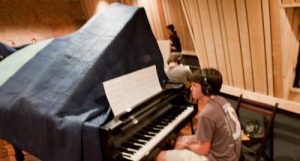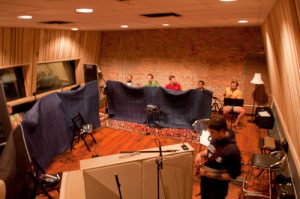We had the pleasure of recording the UNC Big Band in our studio over the past weekend. The band was smokin’ and the session was a blast.
The setup consisted of 5 saxes (two tenor, two alto, one baritone), 4 trumpets, 4 trombones, piano, bass, guitar, and drums. Part of the challenge in recording a band of this size is isolation. You also want to maintain good sight-line between rhythm section members as well as sight-line between the director and entire band. Here at Sound Pure Studio A we have a 1000 sq. ft. live room with two isolation booths (one small, one large). We isolated the drums in the large iso booth and put the guitar amp in the other. The rest of the band was in the live room.
We isolated the piano from the other instruments using moving blankets. These do a surprisingly great job at keeping the other instruments out of the piano mics. The upright bass played behind gobos set in a L-shape. Horn sections were grouped together and isolated from each other with walls of moving blankets and baffles.
Brass instruments (trumpets and trombones) can be really loud and hard to isolate from each other. We used ribbon mics on all of the brass (Coles 4038, Peluso R14, AEA R84 and R92). The results were exceptional. Ribbon mics have a very tight figure-8 pattern and exhibit incredible rejection from the sides. This has to do with the positive and negative lobe of the figure-8 pattern. Sounds that hit the side of the mic go into both lobes and phase cancel. We placed a wall of blanket behind all of the brass mics to limit sound into the back of the mic. It’s really amazing how little bleed there is between mics.
Tonally, most ribbons exhibit high-end roll-off starting around 10k and a really smooth midrange. This is particularly nice for brass instruments because it makes them less harsh and generally delivers a more “mixable” sound.
We used large diaphragm tube condensers on the saxes (Telefunken USA U47, U48, ELA M 251, ELA M 251E and Peluso 2247 SE). This kind of mic exhibits more bleed, but is well worth the tradeoff with the fat, warm sound they deliver. Once again, we used a blanket wall behind the mics to limit high-end bleed into the room.
As the session gets mixed down, we will post some sound clips. Enjoy the attached pics of the setup.




